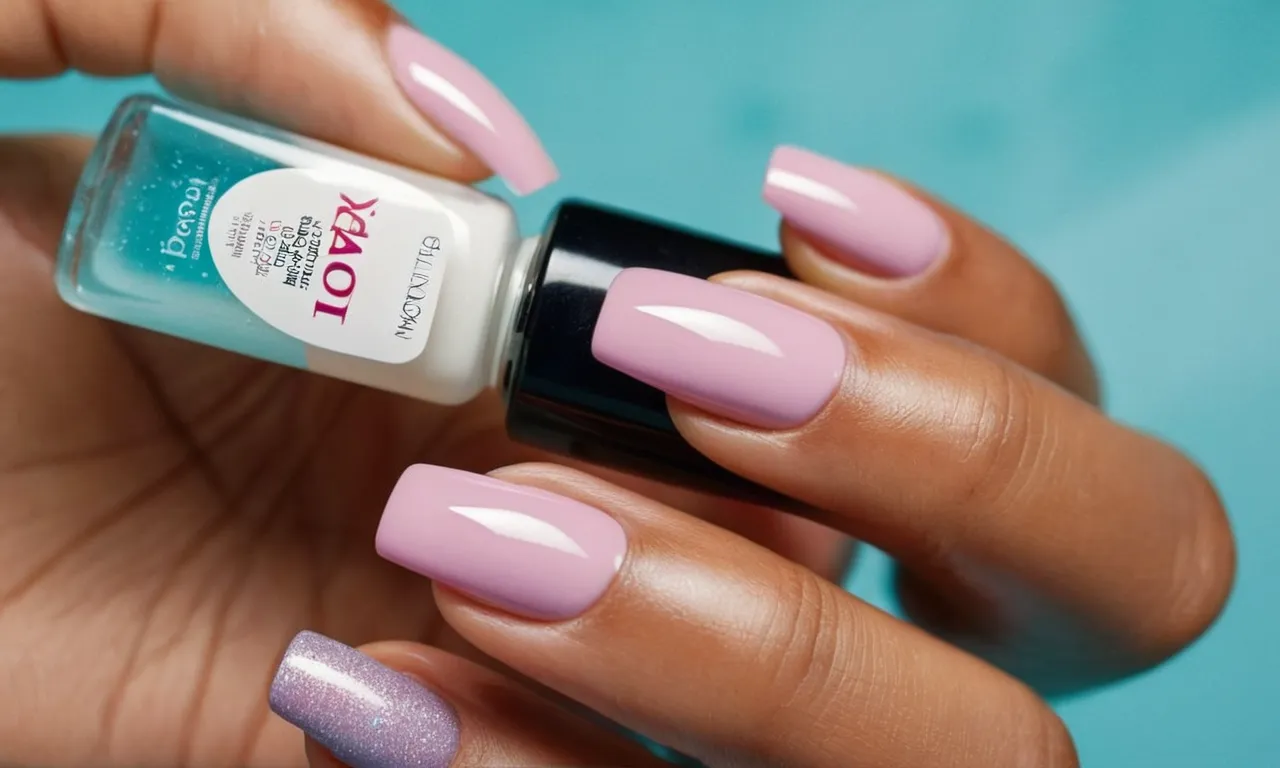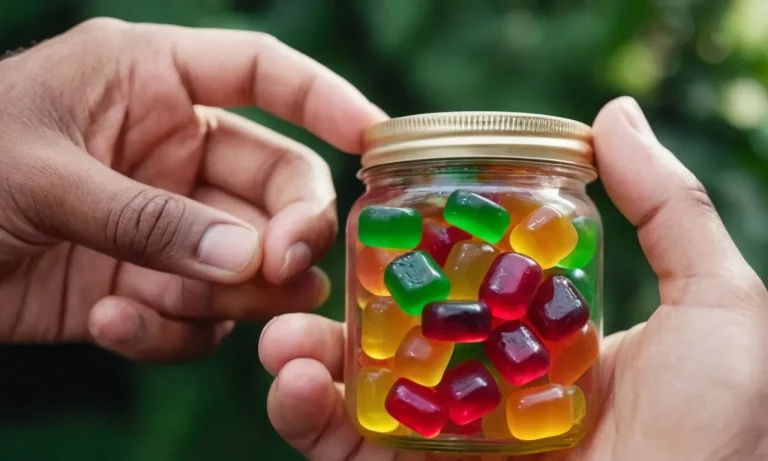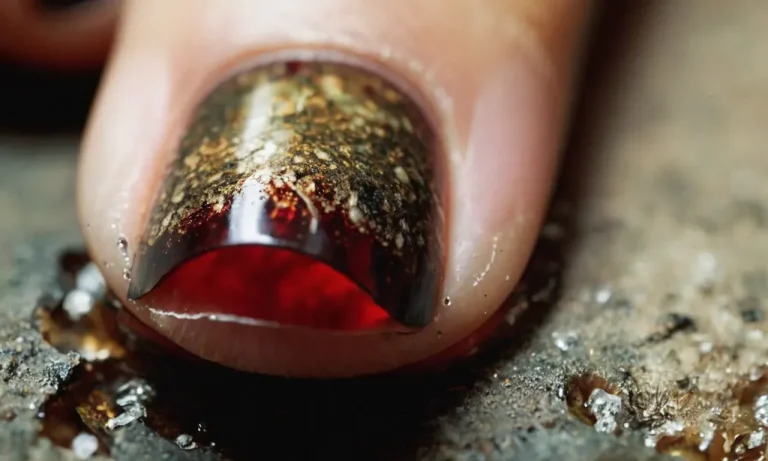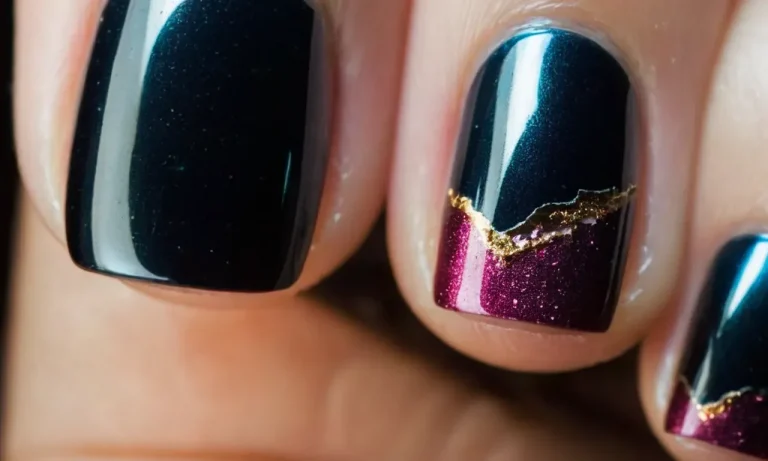How To Get Stain Off Acrylic Nails: A Complete Guide
Have you ever had the misfortune of somehow staining your acrylic nails, marring their perfect look? It can be incredibly frustrating and annoying, especially if you’ve just had them done. Fortunately, there are several tried and tested ways to remove acrylic nail stains and restore their beauty without needing to take them off.
If you’re short on time, here’s a quick answer to your question: soak a cotton ball in nail polish remover or rubbing alcohol and gently dab the stained area for 30-60 seconds until the stain fades. You can also try using toothpaste, lemon juice or whitening toothpaste.
Avoid scrubbing too hard as you don’t want to damage the acrylic.
What Causes Stains on Acrylic Nails
Dark-colored nail polish
Dark-colored nail polishes, especially shades like black, dark blue, and purple, are notorious for staining light-colored acrylic nails. The pigments in these polishes can seep into the acrylic and cause discoloration that’s difficult to remove.
When dark polishes are applied repeatedly without adequate removal between applications, the staining becomes more severe over time.
Artificial coloring like hair dye
Chemicals found in hair dyes, especially darker permanent and semi-permanent options, can also lead to stubborn staining on acrylic nails. The same goes for clothing dyes. The pigments bind to the surface and get trapped within the layers of product used to build acrylic extensions.
This causes unsightly discoloration that requires more than regular maintenance to eliminate.
Certain foods and drinks like coffee and red wine
Foods and beverages with bold, saturated colors often contribute to acrylic nail stains. We’re talking juices, sodas, teas, coffee, and alcohol like red wine. Even spices like turmeric can discolor light acrylics with repeated exposure.
The acids and pigments permeate the product, leaving behind a yellowish or brownish tinge.
Mold and mildew
Neglected acrylic nails that are exposed to excessive moisture can develop mold, mildew, and bacterial buildup. This leads to dark staining, an unpleasant odor, and raised texture on the nails. Proper drying after hand washing and moisture control in between salon fills helps prevent this gross problem.
Smoking
The tar and nicotine residue from cigarette smoke sticks to acrylic nails, causing yellowish-brown staining over time. For smokers, the staining is often more pronounced around the cuticle area where the cigarette is held.
Quitting is the ultimate solution, but minimizing smoke exposure by wearing disposable gloves helps reduce staining.
Cleaning Solutions for Stain Removal
Nail polish remover/acetone
Acetone-based nail polish remover is one of the most effective stain cleaners for acrylic nails. The active ingredient acetone breaks down nail polish and eats through stains. Dip a cotton ball in nail polish remover and rub it on the stained area for 30-60 seconds. Rinse with water.
Acrylic nails can withstand the drying effects better than natural nails. Just avoid exposure longer than 5 minutes (Healthline).
Rubbing alcohol
Like nail polish remover, rubbing alcohol can break down pigments and lift stains through its solvent properties. Soak a cotton ball in 70% isopropyl alcohol and rub the stained acrylic nail for up to 1 minute before rinsing. Start with 30 seconds if you have enhancement or artwork.
The alcohol won’t damage the acrylic itself. This makes it gentler alternative to acetone for sensitive skin.
Lemon juice
The acidic lemon juice acts as a natural bleaching agent to lift superficial stains off the nail surface. Dip a cotton swab in fresh lemon juice and rub it on the stained area for 1 minute. Let it sit 5 more minutes before rinsing. The longer it sits, the better it lifts stains.
You can also make a paste with baking soda to scrub off tougher stains.
Toothpaste and whitening toothpaste
Toothpaste contains mild abrasives that can buff away staining on acrylic nail surface. The whitening types with hydrogen peroxide lift even more stains with its bleaching perks. Rub a small amount of toothpaste over the stain with a toothbrush or cotton swab. Rinse after 1-2 minutes of scrubbing.
Avoid gel toothpaste which can leave residue.
Baking soda
Baking soda efficiently removes yellow stains and brightens acrylic nails. The fine grit acts as a gentle nail polishing agent. Make a thick paste with equal parts baking soda and water. Massage it on stained nails for 1 minute before rinsing. Baking soda is safe for most nail art.
For tough stains, mix with lemon juice to boost cleaning power.
Hydrogen peroxide
The whitening and disinfecting hydrogen peroxide oxidizes stains off acrylic nails. Soak a cotton ball in 3% solution and hold on the stained area for 1 minute. Rinse afterward. The bubbling effect helps lift staining from textured nail art.
Use caution with airbrush paints or nail foil which peroxide can dull.
Denture tablets
While designed for cleaning false teeth, the powerful cleansing ingredients provide an easy solution for removing stubborn stains on acrylics. Dissolve a denture tablet in warm water, then soak nails for 15-20 minutes. The longer soak allows the solution to penetrate deeper stains.
This won’t damage enhancement or nails. The mild abrasives also gently buff the surface.
Methods to Remove Stains from Acrylics
Using nail polish remover or acetone
One of the most effective ways to remove stains from acrylic nails is by using acetone-based nail polish remover. Acetone breaks down the acrylic polymers, allowing you to easily wipe away stubborn stains. Soak a cotton ball with acetone and hold it against the stained area for 1-2 minutes.
Gently rub the stain until it lifts. Be careful not to soak the entire nail, as this can cause the acrylic to lift completely. Limit use to small stained spots only.
Rubbing alcohol soak
For light stains, soaking nails in 90% isopropyl rubbing alcohol for 5-10 minutes can help break down pigment residues. Make sure to dilute stronger alcohols like 99% with water, as full strength can damage nails. Gently scrub with a soft brush after soaking.
The alcohol dissolves debris and oil buildup without being as harsh on acrylics as acetone.
Lemon juice treatment
The natural acidity in lemon juice makes it great for dissolving stains on acrylics. Dip a cotton swab in fresh lemon juice and dab it on the stained area. Let it sit for a few minutes before gently scrubbing with the swab or a soft toothbrush.
The citric acid in lemons bleaches out stains over time without weakening the nail bed underneath.
Toothpaste scrub
Whitening toothpastes contain mild abrasives and bleaching agents that can lift stains from acrylic nails with gentle scrubbing. Apply a small amount of whitening toothpaste to a soft toothbrush and gently scrub stained areas for 2-3 minutes, then rinse.
The toothpaste will safely scour the surface without damaging acrylics. Just don’t use highly abrasive toothpastes, as they could scratch the nails.
Baking soda paste
Make a thick paste with baking soda and water and apply it to stained acrylics. Let it dry completely, then rub it off with a damp cloth or toothbrush. Baking soda is a natural whitener and its fine grit helps exfoliate stains without damaging the nail surface underneath when used gently.
Denture tablet soak
Dissolve 1-2 denture cleaning tablets in warm water and soak acrylic nails for 20-30 minutes. Denture tablets contain powerful cleansers like sodium percarbonate that lift away pigment residues. This soak won’t damage acrylics like acetone soak but still helps erase tough stains.
Just avoid using this method too frequently, as it can dry out the nails.
Whitening gel/toothpaste
Look for whitening products designed specifically for acrylic nails – these contain peroxide bleaching agents to safely lift stains without weakening acrylics. Brush gel onto the nails and let sit for 5-10 minutes before removing.
You can also use small amounts of whitening toothpaste as a scrub a few times a week.
Preventing Future Stains
Apply a protective base and top coat
Applying a base coat and top coat is key for protecting your acrylic nails from stains. The base coat creates a barrier between your natural nails and the acrylic, while the top coat seals everything in. Choose quality polishes that are formulated to be long-lasting.
Reapply the top coat every 2-3 days to maintain that protective shield.
Wear gloves for cleaning, hair dyeing etc.
It’s a good idea to wear gloves when doing household chores, especially those involving chemicals or dyes which can really stain acrylic nails. For example, wear rubber gloves when:
- Washing dishes
- Cleaning the bathroom
- Gardening
- Dyeing your hair
- Using harsh cleaning products like bleach
The gloves form a barrier protecting the acrylic nails from absorbing stains. Better safe than sorry!
Avoid very dark nail polish colors
Darker polish shades like black, deep burgundy or navy blue tend to stain nails more than lighter colors. The pigments in dark polishes can penetrated into the acrylic and become extremely stubborn stains.
If you love vampy nail looks, be extra careful to apply a protective base coat first. Also, don’t wear dark polishes for more than a week at a time before changing to a lighter color. This prevents long-term staining.
Be careful around staining foods and drinks
Foods and beverages containing pigments or dyes can also stain acrylic nails if you’re not careful. Watch out for these common culprits:
- Berries – blueberries, blackberries, raspberries
- Tomatoes
- Beets
- Soy sauce
- Curries and turmeric
- Red wine
- Coffee
- Dark sodas – cola, root beer etc.
After handling foods that may stain, wash your hands immediately to minimize any absorption into the acrylic. You can even apply a little coconut oil which acts as a stain barrier.
Don’t smoke with acrylics on
The tar and nicotine in cigarette smoke can yellow acrylic nails in no time. It stains the nails and gets absorbed deep into the acrylic. If you are smoker, avoid smoking with your acrylics on. The staining is very difficult to remove.
If you must smoke, thoroughly wash your hands afterwards. Also use nail polish remover on the nails to help dissolve any tar residues left over from the cigarette.
Clean under nails regularly
Don’t forget to clean underneath your acrylic nails too! Gently push back the cuticles and use a small brush to scrub away any dirt, oil or staining build up under the nails. Do this each time you wash your hands.
You can also mix a paste of baking soda and lemon juice and use it to scrub the undersides of the nails. This will help prevent staining from accumulating in those hard to reach areas.
Conclusion
In summary, while acrylic nail stains can be annoying, the good news is they can often be removed at home without needing to take your nails off. With the right cleaning solutions and methodical stain removal techniques, you can erase ugly stains and restore the beauty of your nails.
Just remember to also take preventative steps to avoid future stains by applying protective layers, wearing gloves for messy tasks, and being careful around staining substances. Taking good care of your high-maintenance acrylic manicure will help it last longer and continue looking fabulous.







